Pros
Cons
Introduction
Lens & Imaging System
{{section_header}}{{section.name}}{{/section_header}}

The JVC GZ-GX1 has an impressive 1/2.3-inch, 10-megapixel CMOS sensor, which has nearly identical specs to the sensor in JVC's new 4K camcorder that we looked at here. This sensor has far more pixels than is required to capture a Full HD 1080p video image, so those extra pixels are mainly used on the GX1's still image capabilities, which is something JVC still puts quite a bit of energy into.
The lens is has a wide f/1.2 aperture setting and a 29.5mm focal length along with its 10x optical zoom capability. There's also a filter thread on the lens that makes it possible to attach lens converters to the front of the GX1.
Front
{{section_header}}{{section.name}}{{/section_header}}
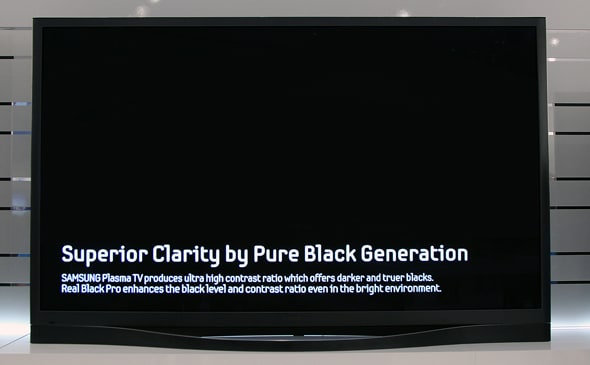
Right
{{section_header}}{{section.name}}{{/section_header}}
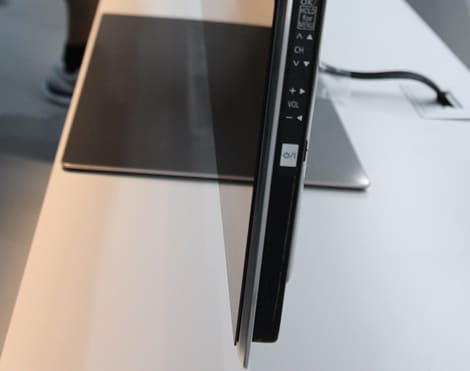
Back
{{section_header}}{{section.name}}{{/section_header}}
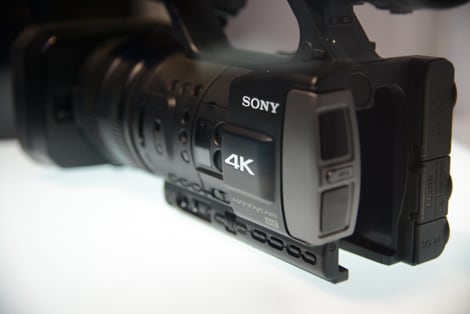
Left
{{section_header}}{{section.name}}{{/section_header}}

Top
{{section_header}}{{section.name}}{{/section_header}}

Bottom
{{section_header}}{{section.name}}{{/section_header}}
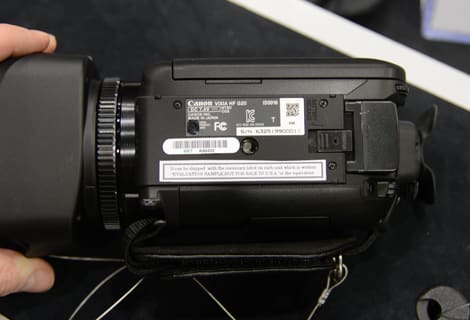
Compression
{{section_header}}{{section.name}}{{/section_header}}
One of the buzz terms this for camcorders this year at CES was AVCHD Progressive or AVCHD 2.0. For those who have yet to do their research, all this means is that AVCHD finally decided to get an update to accommodate progressive recording capability (the ability to record 1080p video). The new AVCHD Progressive also outlined standards for 3D recording, but that doesn't come into play with the GX1.
The GZ-GX1 does allow for 1080/60p recording (that's Full HD recording with a 60p frame rate), which is something that is not found on JVC's other new 2012 Everios. Unfortunately, the GX1 has no standard definition recording function, however, and that is something you get on the JVC V700 and V500 (the step-down models from the GX1).
Read more about the advantages and disadvantages of different compression types.
In addition to 1080/60p recording, the GX1 has four 1080/60i record modes that appear to be identical to the quality options offered on last year's Everio camcorders. The GX1 should show improved performance, though, as it includes the powerful Falconbrid processor engine—a feature that JVC has used before on select models only.
Media
{{section_header}}{{section.name}}{{/section_header}}
JVC opted to keep the GZ-GX1 lean by including no internal memory on the camcorder. This also makes the GX1 a bit cheaper than the flagship models from other manufacturers. In order to record with the camcorder, you'll have to go out and get yourself an SD memory card or two. The camcorder works with SD, SDHC, or SDXC memory cards, which go up to 64GB in size (but you can save money by getting smaller cards, like 16GB or 8GB).
Read more about the advantages and disadvantages of different media types.

According to JVC, the GZ-GX1 loaded with a 64GB card can record around 5 hours of video with its highest-quality 60p setting... or roughly 29 hours of HD video in its lowest quality setting (EP mode).
Editing
{{section_header}}{{section.name}}{{/section_header}}
The camcorder ships with Everio MediaBrowser 4 BE—the same software JVC has included with its Everio camcorders for years. The software may have a few updates this year, we don't know yet, but we'll take a good look at its features when we get a GX1 into our labs.
JVC also announced a feature on the GZ-GX1 that allows you to archive your footage to an external hard drive or Bul-ray disc without connecting the camcorder to a PC. You'll have to use a compatible burner or HDD to perform this operation, though.
Auto Mode
{{section_header}}{{section.name}}{{/section_header}}
Practically every consumer camcorder on the market these days has some kind of dedicated auto mode, but that's not surprising. What is kind of weird, however, is that nearly all of these auto modes—across multiple manufacturers—are called "Intelligent Auto" or something to that effect. Is it us, or did someone simply forget to copyright this term? Anyway, the GX1 has an Intelligent Auto mode that selects the optimal scene mode automatically during shooting. It's not as great of a feature as it sounds, and we're not crazy about it on any camcorder. But it's there, and it works reasonably well.

Low Light Modes
Super Lolux is the GX1's low light mode, and it uses a combination of gain boost and slow shutters to help increase brightness in dark scenes. While this setting will make dark scenes look brighter, it also makes your images choppier and noisier. We're hoping, and our tests may confirm this, that the fast lens on the GX1 will enable it to perform well in low light situations. JVC's track record in low light isn't great, though, so the GZ-GX1 has a weak pedigree when it comes to low light performance.
Zoom
Focus
{{section_header}}{{section.name}}{{/section_header}}
Focus can be set manually on the GZ-GX1—which is great—but the camcorder has no dial or lens ring to make focal adjustments. Instead, you must use the touchscreen interface to adjust focus on the camcorder, which, frankly, is a huge pain.
This makes the manual focus option almost unusable for pros who are used to having the ability to precisely control focus with the rotation of a dial or ring.
Aperture
{{section_header}}{{section.name}}{{/section_header}}
JVC GZ-GX1 has an aperture priority mode, but, like the manual focus option, it kind of sucks to adjust the control. The mode also isn't a full manual setting, as the shutter speed will be automatically tied to the aperture choice of your selection (that's why it is called aperture priority mode).
Shutter Speed
{{section_header}}{{section.name}}{{/section_header}}
Just as with aperture control, the GZ-GX1 has a shutter speed priority setting. It's adjusted using the touchscreen interface (again, not good if you're trying to be precise) and your selection is tied to an automatic aperture value selected by the camcorder.
Other Manual Controls
{{section_header}}{{section.name}}{{/section_header}}
The GZ-GX1 has a strange mix of semi-pro controls, while still lacking certain important manual functions (like a lens ring or dial). You can set white balance manually or choose from a few presets, there's a backlight compensation function, zebra stripes for determining overexposed areas, a tele macro setting, an onscreen grid, and a basic gain on/off feature. We don't mind the lack of fully manual aperture and shutter speed controls (rather than just priority modes), but we really wish the GX1 had some kind of adjustment dial or lens ring. A flagship camcorder of its size and stature really should include one to compete in today's market.
Ease of Use
{{section_header}}{{section.name}}{{/section_header}}
In the past, we've complimented JVC for making camcorders that are relatively intuitive and easy to use. The GZ-GX1 does fall into that category at times, but we found the new intro menu screen to be confusing and strange. It also makes the main menu, where all the important controls are located, somewhat difficult to find. This multiple menu structure is confusing and we're not entirely sure why JVC added the strange opening menu screen.
The camcorder's dedicated auto mode is good and all, but the manual controls are on the GX1 are such a pain to adjust that they're almost pointless. Using the touchscreen is not a great solution for pros or semi-pros who are looking to get precise control over things like aperture, shutter speed, or focus. In the end, this makes the GX1 a better camcorder suited for beginners than it does for semi-pros or advanced videographers.
Handling
{{section_header}}{{section.name}}{{/section_header}}
For the most part, the GZ-GX1 has a traditional camcorder design. It fits well in the palm and it has a plush, adjustable hand strap. The large LCD, while a great feature, does make the left side of the camcorder a bit strange. It sticks up from the rounded top of the camcorder's lens barrel and gives the left side more of a rigid design. We're not that concerned about this strange shape, though, as we're more than happy to see such a large LCD on the camcorder.
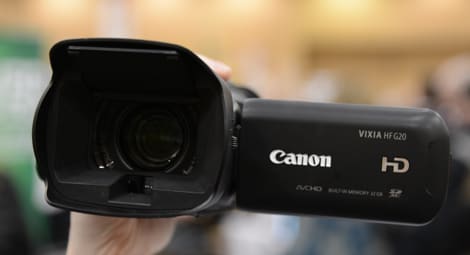
We've said it before and we'll say it again: the JVC GZ-GX1 has some decent features and controls, but the methods for setting these controls isn't very good. The camcorder leaves too much up to the LCD touchscreen, and that's bound to bother some people (unless you really like touchscreens). To top it all off, the GX1 lacks a viewfinder, so all of your video shooting must be performed with the LCD—as well as all of your control adjustments.

The GX1's assignable buttons can be a useful feature for setting controls on the fly, and JVC's new "silent mode" is the kind of feature that camcorders have had for years, but it has always been buried in the menu system before now. The silent mode does what it sounds like: it turns off all the shutter sounds, recording beeps, and noises that the camcorder makes when it is in operation. Nearly all camcorders already had this feature, but you had to go into the menu system and turn sounds off. The JVC GZ-GX1 gives this function a dedicated button inside the LCD cavity. Is it useful? Maybe. But as much as we like turning the sounds off on a camcorder (those beeps can get really annoying when you're reviewing a product), we'd rather have a dedicated button for something more important.

Stabilization
{{section_header}}{{section.name}}{{/section_header}}
The GX1 features optical image stabilization (OIS) with an advanced stabilization mode that appears to mix digital stabilization with the camcorder's optical system. It seems that almost every camcorder manufacturer made some kind of "update" to its stabilization system, and this sort of thing happens every year. We'll have to wait for the GZ-GX1 to get into our labs before we can see how much of an improvement this new OIS system may provide.
Portability
{{section_header}}{{section.name}}{{/section_header}}
For a flagship camcorder, the GZ-GX1 is relatively compact, but compared to JVC's other new Everio camcorders, the GX1 is a behemoth. The GX1 weighs 400g (including its battery pack), which is around 170g heavier than the step-down JVC V700 and V500 camcorders. The dimensions for the GX1 are 57 x 63 x 129mm, putting it in the same company as most other flagship camcorders (actually, a bit more compact than some).
Battery
{{section_header}}{{section.name}}{{/section_header}}
The camcorder comes with a BN-VG114 removable battery pack that charges via the AC adapter that ships with the camcorder. The battery compartment is completely open, as is the norm for high-end camcorders, so you can load in a larger battery pack for longer performance (if you purchase a compatible one separately).

LCD & Viewfinder
{{section_header}}{{section.name}}{{/section_header}}
JVC has completely switched over to a touchscreen interface on the GZ-GX1, so anyone who liked the Laser Touch system from a couple years ago (there's probably not many who did) may be disappointed that it didn't make a comeback. The touchscreen interface isn't the best (it never is), but the 3.5-inch screen is a very good size. The 920,000-pixel resolution is also quite good, although we saw a number of camcorders at CES with screens containing an excess of one million pixels.



Audio Features
{{section_header}}{{section.name}}{{/section_header}}
In addition to an external mic and headphone jack, the GZ-GX1 includes an audio level adjustment option, a zoom mic feature, headphone volume adjustment, and JVC's K2 audio recording technology (which sounds more special than it really is). The most important feature here is the external mic jack, as that gives you the flexibility to actually connect good microphones to the camcorder. It's not as great as an XLR input, but it is as good as you're gonna get on a flagship consumer camcorder.

Connectivity
Still Features
Other Features
{{section_header}}{{section.name}}{{/section_header}}
WiFi
WiFi has finally made its way into a bunch of a camcorders this year, and, while we're still not sold on all the capabilities, we must say that JVC has done the most with the new WiFi function. Here's a quick roundup of the camcorder's WiFi features: real time monitoring on a smartphone using a free application, live video feed viewing from anywhere via a wireless access point, home detection monitoring (with the camcorder's auto record feature), video clip emailing, smartphone linking and web video upload, and remote recording via a smartphone.
Some of these features sound cooler than others, and we were only able to see a few of them in action at CES, but all of them are worth talking about. To use most of the live monitoring features on the GX1, you must download a free app that is available for Android or Apple products. This allows you to do real-time monitoring from another room on the same WiFi network as the camcorder. You can also watch the GX1's live video feed from anywhere via an access point (likely through a website) that does not require you to be on the same wireless network as the camcorder.
The "Home Detection Monitoring" feature isn't much different than the video feed function, except it enables the camcorder to record a snapshot whenever a new subject enters the frame (it's almost exactly like the auto record feature that starts recording automatically when something enters the frame).
We're very curious as to how well the emailing function works on the GZ-GX1, as we're dubious that a camcorder can setup a streamlined direct upload system as well as, say, the Apple iPhone can. JVC claims the email video function is limited to a 15-second clip, the video is downsized to 640 x 360, and up to eight email recipients can be preset for simultaneous emailing.
For uploading video to YouTube or Facebook, it appears you are required to link the GX1 with your smartphone first. After linking to your smartphone (with the free Android or Apple app), you can then use your phone to upload video shot with the GX1 to the web.
The remote recording function with the free app is also very cool, and we're excited to try it out with the GX1. You can start/stop recording with your smartphone, as well as perform zooms remotely. It's kind of like having a wireless remote control, except the screen on the phone can function as an LCD, and presumably the remote function works over a much farther distance than a traditional remote control.
Annimation Effect
Another new feature JVC is pushing on the GX1 is an animation effect option that allows you to put various objects and animations around your subject during recording. Ever wanted to put a hat and glasses on your kid while you record them at the dinner table? Now you can.

Time-Lapse Record
Time-lapse record is a carry-over feature that JVC has used included on most of its previous Everios. It lets you set a time interval and record short clips over that interval (to produce a time-lapse effect).
Auto Record
Another feature that has been on past JVC Everios is Auto Record. This allows you to set the GX1 up, turn Auto Record on, and the camcorder will automatically start recording when a new subject is detected within the frame. Some call this the "nanny-cam" feature, as it can be used to keep tabs on babysitters or the like (if you put the camcorder in a hidden location).
Video Light
The GX1 has a built-in video light (along with a flash) that can give you a boost when you're shooting in low light situations.
Conclusion
JVC is certainly capable of producing great camcorders, and they've shown us very good models in the past. Unfortunately, last year the company didn't show us anything all that impressive, which is why we're looking forward to getting our hands on the new Everio GZ-GX1 for a full-length review. The camcorder has impressive specs, with Full HD 60p recording, a large 3.5-inch touchscreen, and a host of new WiFi-related features.
At CES we weren't able to try out many of the GX1's WiFi functions on the show floor, so we're particularly excited to check out those new features when we get a GX1 into our labs. The video performance of the camcorder is also high on our list as something we want to test. JVC budgets its flagship model at a slightly lower price ($899 MSRP) than other manufacturers, so the GZ-GX1 has the potential to be a great bargain for a flagship model in 2012—as long as the performance and new features live up to their billing.
Photo Gallery
{{photo_gallery "FI Lens Image", "FI Front Image", "FI Right Image", "FI Back Image", "FI Left Image", "FI Left Open Image", "FI Top Image", "FI Bottom Image", "FI Media Image", "FI Easy Mode Image", "FI Zoom Image", "FI Zoom Image 2", "FI 3D Lens Image", "FI 3D Lens Image 2", "FI 3D Physical Controls", "FI 3D Physical Controls 2", "FI Handling Image", "FI Handling Image 2", "FI Handling Image 3", "FI Battery Image", "FI LCD Image", "FI Viewfinder Image", "FI Viewfinder Image 2", "FI Playback Image", "FI Mic Image", "FI Flash Image", "FI Photo Mode Image", "FI Ports Image 1", "FI Ports Image 2", "FI Ports Image 3", "FI Ports Image 4", "FI Ports Image 5", "FI Ports Image 6"}}
Specs
{{manufacturer_specs_table}}
Meet the tester
Jeremy is the video expert of our imaging team and Reviewed.com's head of video production. Originally from Pennsylvania and upstate NY, he graduated from Bard college with a degree in film and electronic media. He has been living and working in New England since 2005.
Checking our work.
Our team is here to help you buy the best stuff and love what you own. Our writers, editors, and experts obsess over the products we cover to make sure you're confident and satisfied. Have a different opinion about something we recommend? Email us and we'll compare notes.
Shoot us an email

